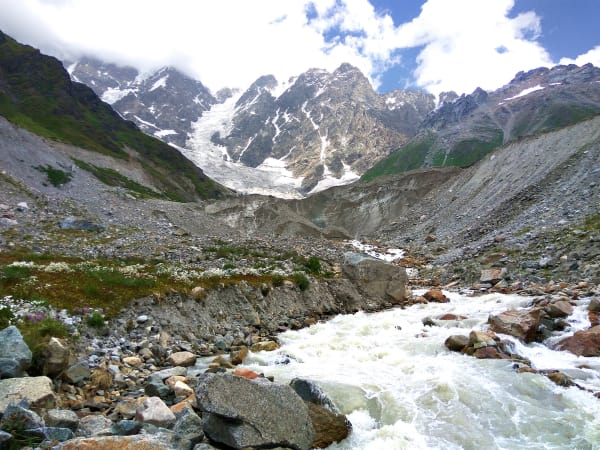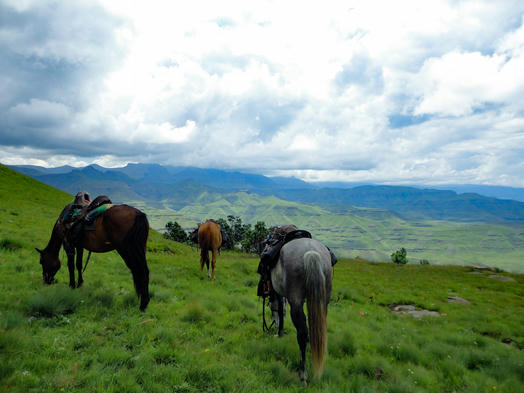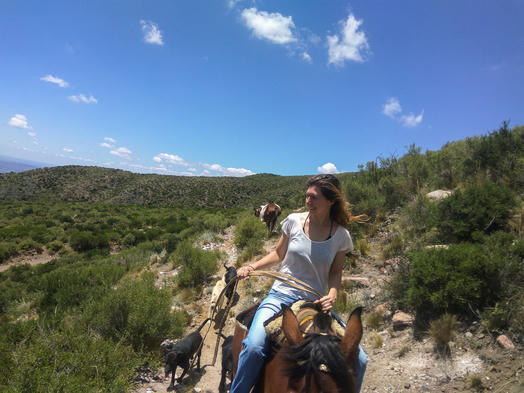This day stayed in my memory for exceptional horse riding in Ushguli. Here we will tell you what you might expect if you want to explore Svanetia - the most distant part of the Caucasus - on horseback.

We had arranged for horses the day before – there are several guesthouses with a "rent a horse" sign. We named the riding arrangements “Kitty's nightmare”. Kitty is the owner of the stables we used to ride at regularly since it is close to Berlin (where we are based). The horses there are taken care of in the best possible fashion – to such extent, that almost half of the time it was too hot or too cold for the horses to be engaged in the activity of riding. (That got me by surprise as the stables in Ukraine I started riding at never suggested that the weather conditions were unsuitable - neither during the plus 35° hot summer months nor during the cold winter months) The riders' skills are carefully examined during a trial ride before one is actually allowed to participate in a guided riding tour out in the forest. The riders are well equipped with helmets, vests, even riding pants if they happen to not have any on their own. But well, this is common for many German stables. Now we come to our Svan arrangements.
Us: "And can we also canter?" The horse rental: "Sure, if you can" Us: "no, we mean the actual condition of the track… wether is it good enough for cantering. Where would we ride then?" The horse rental: "There" – pointing in the direction of the glacier and adding some unknown word either in Svan or in Georgian which I supposed meant the Glacier Us "But how would we find the way?" The horse rentals: "Everybody goes there" Us: "Where?" The horse rentals (slightly annoyed with our stupidity): "There" – pointing in the direction of the glacier and adding some unknown word either in Svan or in Georgian. "You may also pay for a guide if you feel insecure but then pay for an extra horse as well."
Sure, we didn't get any helmets or vests. What we got was an unusual saddle, a metallic carcass with a cushion and really really short stirrups which one couldn't adjust to make them any longer.


But let me tell you about the ride: The first part of the way, shared with 4x4s, bringing hikers to the actual beginning of the trail and the vast majority of regular hikers was suitable for trotting and cantering. But we didn't hurry and took some long breaks to give our horses some rest. When the path gets narrow you may still continue on the horse's back but at a slower pace. After a while getting forward turns into jumping from one big stone to the next, which is better executed separately from the horse. And then we faced the truth: the path would just get worse and steeper as well. We also figured out why the other horses had been tied to trees at the beginning of the narrow trail.


On our way back we let our horses run on the broader road as fast as they wanted to go and reached the village of Ushguli 4 hours after we had left. But the saddle and the stirrups had soon made our knees and butts sore and so we returned our horses. Had the saddles been any better we would have kept the horses till sundown. The proud price we paid for renting the horses was 50 Lari – 18 Euros for a day.

Having checked all of the four small shops in the village of Ushguli we finally had got some water, bread and cheese and left for the next village. We drove about 6 km – which took us half an hour – thinking back of Ushguli and thinking that we were hardly likely to find another place as scenic and suitable for our campsite as the one we had had there, and for the first time in our journey we returned to a place we had been at before.

it is you who keeps our site running and helps us grow and bring you more stories from our trips and the local people we encounter. We believe that telling these stories brings the world closer together and is hence a way to make a positive change! Please support us with a small donation on the kofi platform. Even a small contribution makes a big difference!




